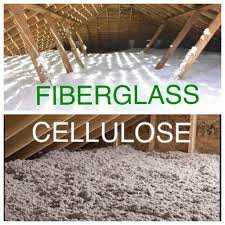
Insulation…lets get started!
With so many worthwhile benefits to having insulation installed in your home, it’s a tough call to know which type of insulation to go for. You’ll need to factor in the budget, the construction of your house, where you want to add insulation, and any present issues like dampness or cracks.
Here’s a quick overview,
Fiberglass
Crafted from spun, molten glass, fiberglass is one of the most commonly used insulation materials. It’s relatively inexpensive and comes in a blanket and loose fiber formats, depending on the application you need.
The blanket kind is often referred to as ‘batt’ and looks like a thick sheet or roll (like a blanket). You might be familiar with batt if you’ve ever seen or installed insulation in an attic, as it’s perfect for covering unobstructed areas.
Blown-in fiberglass is more often used in spaces where there are obstructions – think the cavities in your walls, or covered floor spaces.
To install it, you need specialist equipment to blow the fibers into place, so it’s best to work with a professional.
As it’s heat resistant, fiberglass is also used as duct insulation, ideal if you’re insulating around pipework.
The only downside you need to bear in mind is that fiberglass may trap unwanted moisture, for example, from a roof leak or condensation. Moisture can lead to mold and decrease the effectiveness of the insulation, so be wary!
Cellulose
Cellulose is a practical, inexpensive solution to fill the walls and attic floor of your existing home. It comes in loose fibers made from recycled paper and wood products. It’s treated with borates to make it fire retardant and insect resistant, then blown in.
Other types of insulation may require you to rip down drywall to access cavities. To lay fiberglass batts, for example, you’d need access to the entire inner wall space. With blown-in cellulose, your specialist only needs to make a few holes which then get plugged up and covered over.
Cellulose fibers, over time, can settle, creating pockets of air which can render your insulation less effective. If the insulation gets moisture damage, this can also decrease its R-value.
Cost-wise, cellulose is around the same price as blown-in fiberglass, making it an affordable choice to insulate your home.
Hopeful that this helps you with some basic information about insulation, more to follow in upcoming blogs, in the mean time please reach out to Koala Insulation of Cincinnati to help you answer any questions that you may have around energy efficiency, insulation and ventilation in your home or building to improve the efficiency as well as the comfort of those working or living in those conditioned spaces!
Ready to book your free insulation evaluation?
We have 3 convienant ways for you to get in touch
We Provide Insulation Services to the Following Cincinnati Areas
CAMP DENNISON, MILFORD, TERRACE PARK, CINCINNATI, WEST CHESTER, FRANKLIN, LEBANON, MIDDLETOWN, MONROE, SPRINGBORO, TRENTON, KINGS MILLS, MAINEVILLE, MASON, SOUTH LEBANON, LOVELAND, MORROW
Counties Served
HAMILTON, CLERMONT, BUTLER, WARREN
Zip Code
45111, 45150, 45174, 45208, 45209, 45212, 45213, 45226, 45227, 45230, 45236, 45243, 45244, 45069, 45215, 45218, 45231, 45240, 45241, 45246, 45005, 45036, 45042, 45044, 45050, 45066, 45067, 45034, 45039, 45040, 45065, 45140, 45152, 45242, 45249
